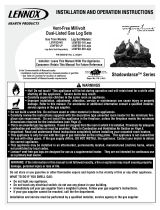OPERATION
FOR YOUR SAFETY READ BEFORE LIGHTING
A. This appliance has a pilot which is lighted by a
spark
igniter system. When lighting the pilot, follow
these
instructions exactly.
B. BEFORE LIGHTING smell all around the appliance
area for gas. Be sure to smell next to the floor
because some gas is heavier than air and will
settle on the floor.
WHAT TO DO IF YOU SMELL GAS:
*Do not try to light any appliance.
*Do not touch any electric switch; do not use any
phone in your building.
* Immediately call your gas supplier from a neighbor’s
phone. Follow the gas supplier's instructions.
*If you cannot reach your gas supplier, call the fire
department.
WARNING:
If you do not follow these
instructions exactly, a fire or explosion may
result causing property damage, personal
injury or loss of life.
C. Use only your hand to push in or turn the gas
control knob. Never use tools. If the knob will not
push in or turn by hand, do not try to repair it, call a
qualified service technician. Force or attempt repair
may result in a fire or explosion and may void your
warranty.
D. Do not use this appliance if any part has been under
water. Immediately call a qualified service technician to
inspect the appliance and to replace any part of the
control system and any gas control which has been
under water.
LIGHTING INSTRUCTIONS
1. STOP! Read the safety information above on this
label.
2. Turn off all electrical power in firebox before
installing.
3. Depress the control knob and turn clockwise
as far as it will go to reach the “OFF” position.
4. Wait five (5) minutes to clear out any gas. Then
smell for gas, including near the floor. If you
smell gas, STOP! Follow “B” in the safety
information above on this label. If you do not
smell gas, go to the next step.
5.
Depress the control knob and turn
counterclockwise to the “PILOT” position.
Fig 10 GAS CONTROL
gas control knob to "OFF" and call your service
technician or gas supplier.
9.
Depress the control knob
and turn counterclockwise
to “ON”. Turn flame height knob
counterclockwise to select desired comfort level.
Control
Knob
•
Push in control knob all the way and
hold in.
NOTE: A periodic visual check of the pilot flames
(Figure 11) and main burner flames (Figure 12) should
be made. The pilot flame should always be present
when the appliance is in operation. See illustrations
below.
•
If the control knob is not held in
all the way the pilot will not stay lit
when the knob is released.
•
Do not turn the knob when pushing it in.
•
Light the pilot (mounted in front of the back burner)
by pushing the spark igniter button several times.
This will cause a spark at the pilot which will ignite
the pilot gas. If the spark does not work, light the
pilot with a match.
* When lighting the pilot it may take several seconds for
gas to reach the pilot.
•
Continue to hold the control knob in all the way for
Fig 11
NATURAL GAS
ODS PILOT
LIQUID PROPANE
ODS PILOT
about 30 seconds after the pilot is lit.
9.
t. The pilot
Fig 12 MAIN BURNER
Release the knob and it will pop back u
should remain lit. If it goes out, repeat steps 3 through
9.
* If knob does not pop up when released, stop and
immediately call your service technician or gas
supplier.
* If the pilot will not stay lit after several tries, turn
the
11



















